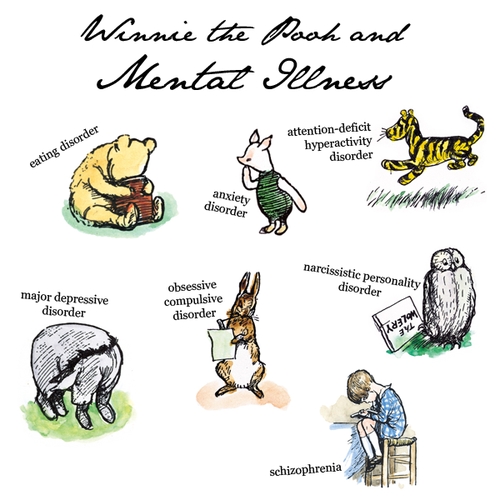Winnie The Pooh Characters & Mental Disorders: A Deep Dive
Could the whimsical world of Winnie the Pooh, a place of honey pots and friendly faces, also be a subtle reflection of the complexities of mental health? The enduring popularity of A.A. Milne's Hundred Acre Wood tales has, in fact, fueled a fascinating theory: that each beloved character embodies a different mental disorder.
This idea, initially seeming like a stretch, gains traction the more one considers the distinct personalities and behaviors of Pooh, Piglet, Eeyore, Tigger, and Rabbit. While the stories never explicitly diagnose these characters, their actions and emotional states resonate with recognized mental health patterns. Is it possible that Milne, intentionally or not, crafted a narrative that subtly introduces children to the spectrum of human emotional experiences, from anxiety and depression to impulsivity and obsessive tendencies?
The concept that these characters represent specific mental health conditions isn't a recent invention. It gained prominence through a 2000 article published in the Canadian Medical Association Journal, titled "Pathology in the Hundred Acre Wood: A Neurodevelopmental Perspective on A.A. Milne." This article, along with subsequent analyses, has sparked widespread discussion about the potential psychological underpinnings of the characters actions.
The core of the theory lies in recognizing the consistency of the characters' behaviors and the ways in which they reflect patterns seen in real-world mental health conditions. Winnie the Pooh's preoccupation with honey could be viewed as a manifestation of an eating disorder or even impulsivity. Piglet's constant anxiety and timidity align with the symptoms of generalized anxiety disorder. Eeyore's pervasive sadness and pessimistic outlook are strongly suggestive of dysthymia, a persistent depressive disorder. Tigger's boundless energy, impulsiveness, and distractibility bear the hallmarks of Attention-Deficit/Hyperactivity Disorder (ADHD). And Rabbit's obsessive planning and control-oriented nature could be indicative of obsessive-compulsive disorder (OCD).
It's crucial to reiterate that these interpretations are not intended as formal diagnoses. Instead, they serve as a fascinating lens through which to appreciate the depth and nuance of Milne's storytelling and the potential for children's literature to subtly address complex human experiences. While A.A. Milne likely didn't intentionally set out to create a cast of characters representing specific mental illnesses, the enduring power of his work lies in its ability to reflect the realities of human nature. It's a testament to the profound impact of these characters that their struggles and triumphs can still resonate with audiences of all ages today.
Here is a table representing each character and the potential mental health conditions they might embody, along with associated behaviors:
| Character | Potential Mental Health Condition | Associated Behaviors |
|---|---|---|
| Winnie the Pooh | Eating Disorder, Impulsivity, Obsessiveness | Preoccupation with honey, impulsively eating honey, obsessive behavior related to honey, difficulty with delayed gratification. |
| Piglet | Generalized Anxiety Disorder | Constant worry and fear, nervousness, shyness, stuttering, low self-esteem, tendency to retreat from social situations. |
| Eeyore | Dysthymia (Persistent Depressive Disorder) | Pervasive sadness, pessimism, low energy, lack of motivation, feelings of hopelessness, social withdrawal. |
| Tigger | Attention-Deficit/Hyperactivity Disorder (ADHD) | Hyperactivity, impulsivity, inattentiveness, difficulty focusing, fidgeting, easily distracted, difficulty following instructions. |
| Rabbit | Obsessive-Compulsive Disorder (OCD) | Obsessive planning, need for control, perfectionism, excessive organization, rigidity, anxiety related to deviations from routine. |
| Christopher Robin | Possible Schizophrenia (as a character that brings the stuffed animals to life) | May be experiencing altered perception of reality, hearing and seeing things that are not there, and displaying a detachment from reality. |
For more in-depth information about mental health conditions, you can visit the National Institute of Mental Health (NIMH) website: https://www.nimh.nih.gov/. This website provides valuable resources on mental health research, treatment, and support.
This perspective encourages us to reconsider the seemingly simple stories of Winnie the Pooh and his friends as rich explorations of the human condition. The Hundred Acre Wood becomes a microcosm of the world, reflecting the diverse range of human emotions and experiences, and the challenges that come with them. Understanding these characters, and the potential mental health struggles they represent, can offer a starting point for conversations about mental health, both for children and adults.
The enduring appeal of the Winnie the Pooh stories lies not just in their sweetness and charm, but also in their ability to provide comfort and understanding. The strong friendships depicted in the Hundred Acre Wood, particularly those between Piglet and Christopher Robin, demonstrate the importance of social support in managing mental health challenges. The characters' willingness to accept each other's differences, to offer support and companionship, and to navigate challenges together, offers a powerful message about the importance of empathy and kindness in creating a supportive and inclusive community.
While the theory linking Winnie the Pooh characters to mental disorders may have been popularized by the Canadian Medical Association Journal article, it is important to note that A.A. Milne died in 1956, and the formal diagnostic categories for many of these conditions didn't exist in the same way they do today. Nevertheless, the observations and the resulting discussion highlights how relatable the characters are to the human condition, and how the behaviours can be interpreted to provide insight into the world of mental disorders.
Perhaps, this is the key, for many, it tapped into a number of rather blatant truths about some of the world's most adored characters. In revisiting the Hundred Acre Wood with this perspective, we can gain a deeper understanding of the characters, and the complex mental health challenges they might embody, and use that understanding to foster empathy, increase awareness, and encourage conversations about mental health in an accessible and relatable way.


